Orchard
An orchard is an intentional plantation of trees or shrubs that is maintained for food production. Orchards comprise fruit- or nut-producing trees which are generally grown for commercial production. Orchards are also sometimes a feature of large gardens, where they serve an aesthetic as well as a productive purpose.[1] A fruit garden is generally synonymous with an orchard, although it is set on a smaller non-commercial scale and may emphasize berry shrubs in preference to fruit trees. Most temperate-zone orchards are laid out in a regular grid, with a grazed or mown grass or bare soil base that makes maintenance and fruit gathering easy.
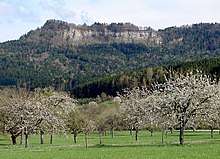
Most orchards are planted for a single variety of fruit. While the importance of introducing biodiversity is recognized in forest plantations, it would seem to be beneficial to introduce some genetic diversity in orchard plantations as well by interspersing other trees through the orchard. Genetic diversity in an orchard would provide resilience to pests and diseases just as in forests [2].
Orchards are sometimes concentrated near bodies of water where climatic extremes are moderated and blossom time is retarded until frost danger is past.
Layout
An orchard's layout is the technique of planting the crops in a proper system. There are different methods of planting and thus different layouts. Some of these layout types include:
- Square method
- Rectangular method
- Quincunx method
- Triangular method
- Hexagonal method
- Contour or terrace method
For different varieties, these systems may vary to some extent.
Orchards by region
The most extensive orchards in the United States are apple and orange orchards, although citrus orchards are more commonly called groves. The most extensive apple orchard area is in eastern Washington state, with a lesser but significant apple orchard area in most of Upstate New York. Extensive orange orchards are found in Florida and southern California, where they are more widely known as 'groves'. In eastern North America, many orchards are along the shores of Lake Michigan (such as the Fruit Ridge Region), Lake Erie, and Lake Ontario.
In Canada, apple and other fruit orchards are widespread on the Niagara Peninsula, south of Lake Ontario. This region is known as Canada Fruitbelt and, in addition to large-scale commercial fruit marketing, it encourages "pick-your-own" activities in the harvest season.
Murcia is a major orchard area (or la huerta) in Europe, with citrus crops. New Zealand, China, Argentina and Chile also have extensive apple orchards.
Tenbury Wells in Worcestershire has been called The Town in the Orchard, since the 19th century, because it was surrounded by extensive orchards. Today, this heritage is celebrated through an annual Applefest.[3]
Central Europe
Streuobstwiese (pl. Streuobstwiesen) is a German word that means a meadow with scattered fruit trees or fruit trees that are planted in a field.[4] Streuobstwiese, or a meadow orchard,[5] is a traditional landscape in the temperate, maritime climate of continental Western Europe. In the 19th and early 20th centuries, Streuobstwiesen were a kind of a rural community orchard that were intended for productive cultivation of stone fruit. In recent years, ecologists have successfully lobbied for state subsidies to valuable habitats, biodiversity and natural landscapes, which are also used to preserve old meadow orchards. Both conventional and meadow orchards provide a suitable habitat for many animal species that live in a cultured landscape. A notable example is the hoopoe that nests in tree hollows of old fruit trees and, in the absence of alternative nesting sites, is threatened in many parts of Europe because of the destruction of old orchards.[6]
- Orchard in various regions
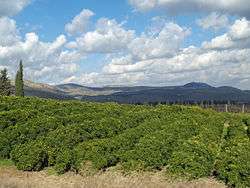
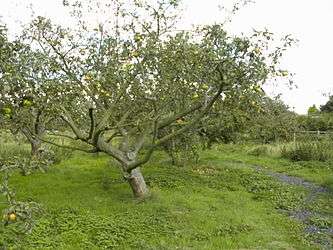
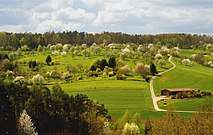 Streuobstwiese, a rural community orchard, traditionally for productive use. Today endorsed for its quality of habitat and biodiversity
Streuobstwiese, a rural community orchard, traditionally for productive use. Today endorsed for its quality of habitat and biodiversity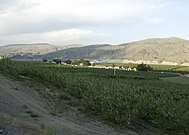 Apple orchards in Azwell, Washington surrounding a community of pickers' cabins
Apple orchards in Azwell, Washington surrounding a community of pickers' cabins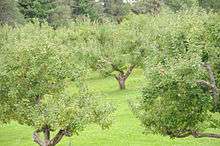 Old growth apple orchard in Ottawa, Canada
Old growth apple orchard in Ottawa, Canada
Historical orchards
- Orchard House in Concord, Massachusetts was the residence of American celebrated writer Louisa May Alcott.
- Fruita, Utah part of Capitol Reef National Park has Mormon pioneer orchards maintained by the United States National Park Service.
Modern orchards
Historical orchards have large, mature trees spaced for heavy equipment. Modern commercial apple orchards, by contrast and as one example, are often "high-density" (tree density above 370/ha or 150/acre), and in extreme cases have up to 22,000/ha (9,000/acre). These plants are no longer trees in the traditional sense, but instead resemble vines on dwarf stock and require trellises to support them.[7]
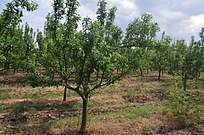 Pear orchard in Sirkovo, North Macedonia
Pear orchard in Sirkovo, North Macedonia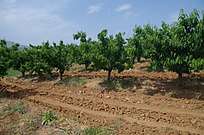 Cherry orchard in Sirkovo, North Macedonia
Cherry orchard in Sirkovo, North Macedonia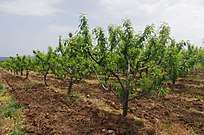 Peach orchard in Sirkovo, North Macedonia
Peach orchard in Sirkovo, North Macedonia
Orchard conservation in the UK
- Natural England, through its Countryside Stewardship Scheme, Environmental Stewardship and Environmentally Sensitive Areas Scheme, gives grant aid and advice for the maintenance, enhancement or re-creation of historical orchards.[8]
- The 'Orchard Link' organisation provides advice on how to manage and restore the county of Devon's orchards, as well as enabling the local community to use the local orchard produce.[9] An organisation called 'Orchards Live' carries out similar work in North Devon.[10]
- People's Trust for Endangered Species (PTES) has mapped every traditional orchard within England and Wales and manages the national inventory for this habitat.[11]
- The UK Biodiversity Partnership lists traditional orchards and a priority UK Biodiversity Action Plan habitat.[12]
- The Wiltshire Traditional Orchards Project maps, conserves and restores traditional orchards within Wiltshire, England.
See also
References
- Luther Burbank. Practical Orchard Plans and Methods: How to Begin and Carry on the Work. The Minerva Group. ISBN 1-4147-0141-1.
- Konnert, M., Fady, B., Gömöry, D., A’Hara, S., Wolter, F., Ducci, F., Koskela, J., Bozzano, M., Maaten, T. and Kowalczyk, J. (2015). "Use and transfer of forest reproductive material in Europe in the context of climate change" (PDF). European Forest Genetic Resources Programme, Bioversity International, Rome, Italy.: xvi and 75 p. Archived (PDF) from the original on 2017-08-04.CS1 maint: multiple names: authors list (link)
- "The Teme Valley Times supports the Tenbury Applefest". applefest.org.uk. Archived from the original on 2017-06-26. Retrieved 2020-04-26.
- "dict.cc dictionary :: Streuobstwiese :: German-English translation". dict.cc.
- Streuobstwiese: meadow orchard in German-English Collins Dictionary
- Berhens M. Why hoopoes won't trade. A Pro Natura Publication on the Global Economy and Nature. Pro Natura, Switzerland, pp. 8-9. Archived March 27, 2009, at the Wayback Machine
- Parker, Michael; et al. "High Density Apple Orchard Management". North Carolina State University. Retrieved 26 July 2017.
- Entry Level Stewardship Handbook. Natural England. 2008. p. 29. ISBN 978-1-84754-080-5.
- "Welcome to orchardlink.org.uk". orchardlink.org.uk.
- "Orchards Live - About Us". orchardslive.org.uk.
- PTES Traditional Orchard Survey
- UK BAP
External links
| Wikimedia Commons has media related to Orchard. |
- Home Orchard Society
- Pennsylvania tree fruit production guide; a guide on how to set up an orchard in practice
- Chisholm, Hugh, ed. (1911). . Encyclopædia Britannica (11th ed.). Cambridge University Press.